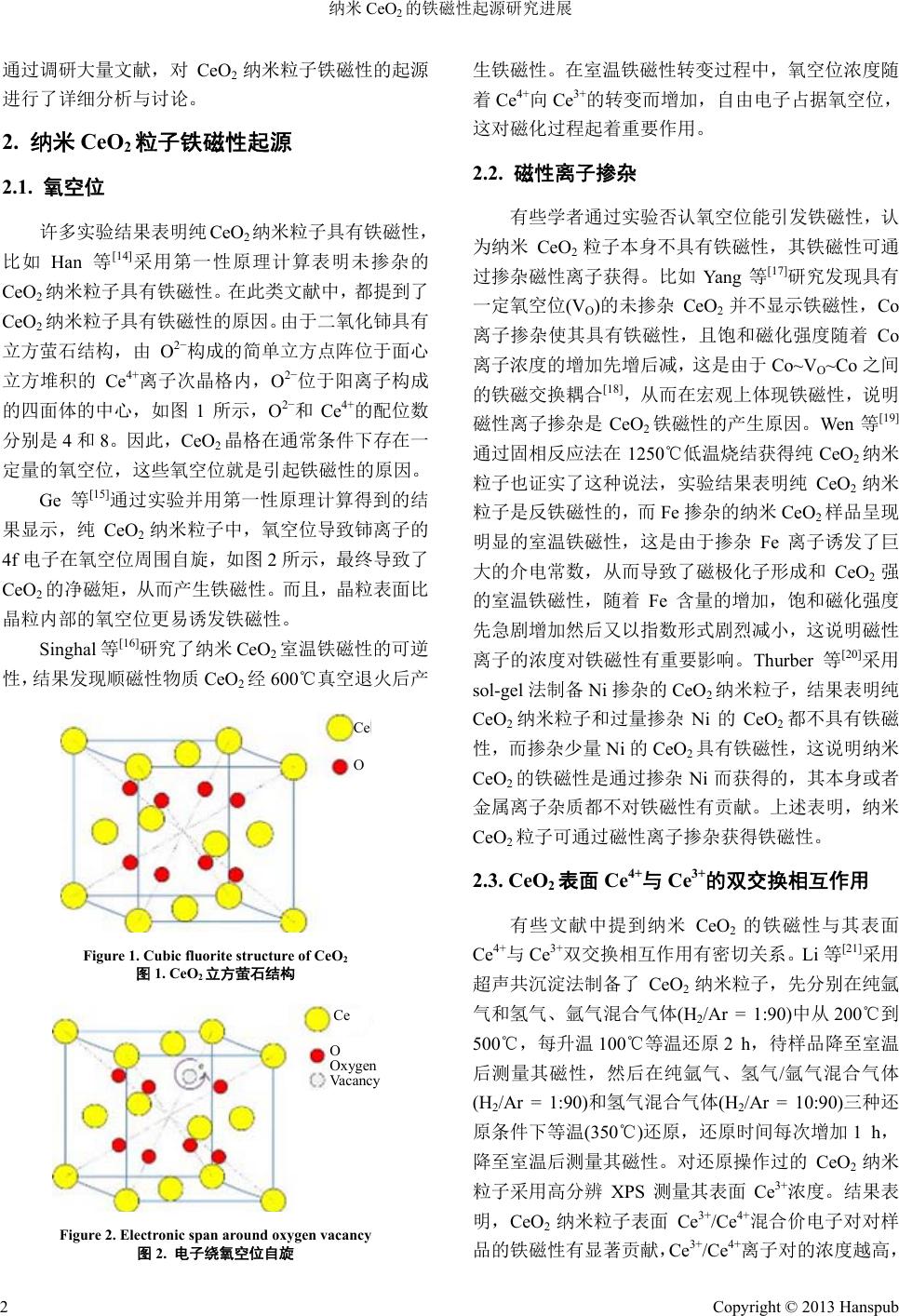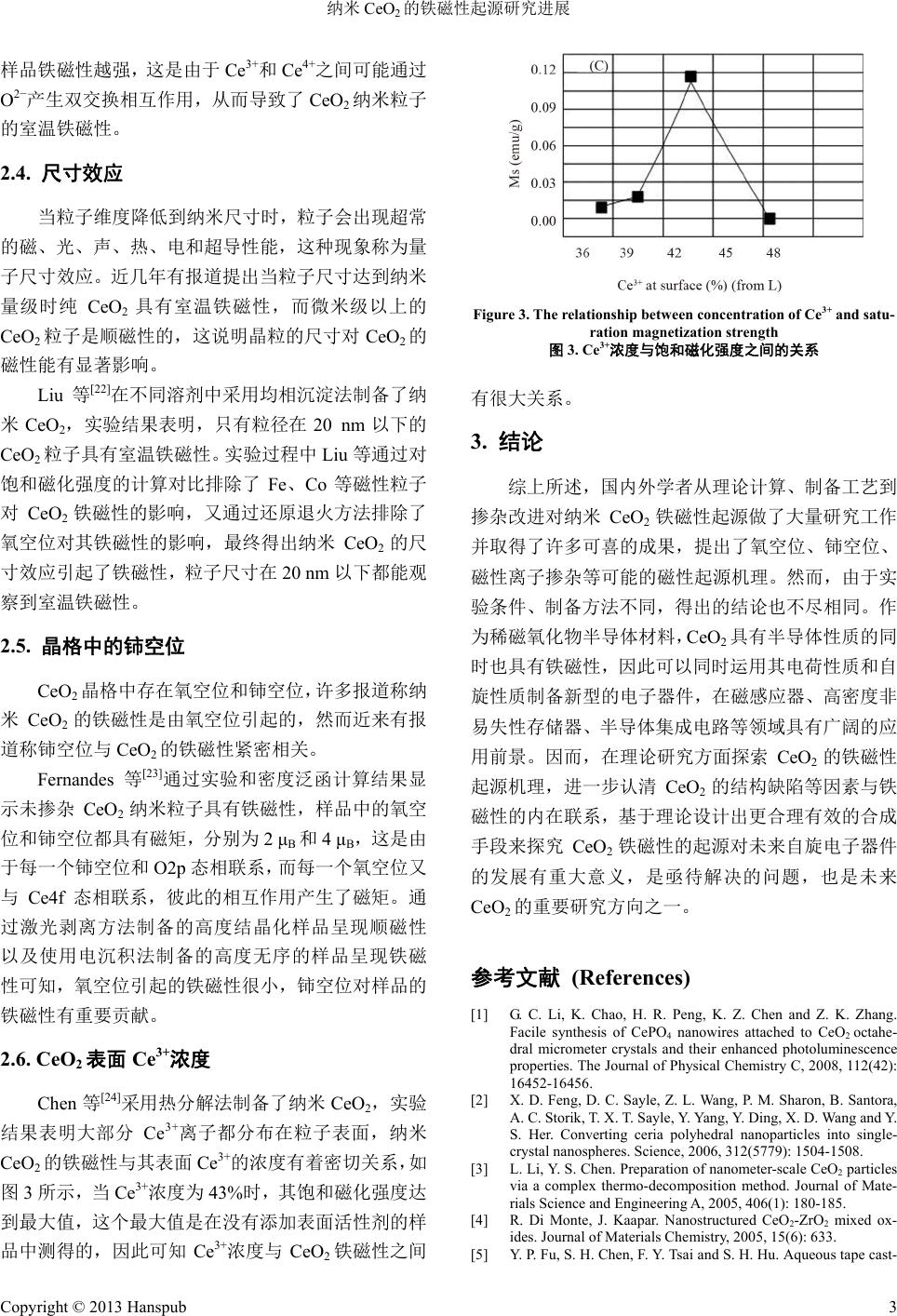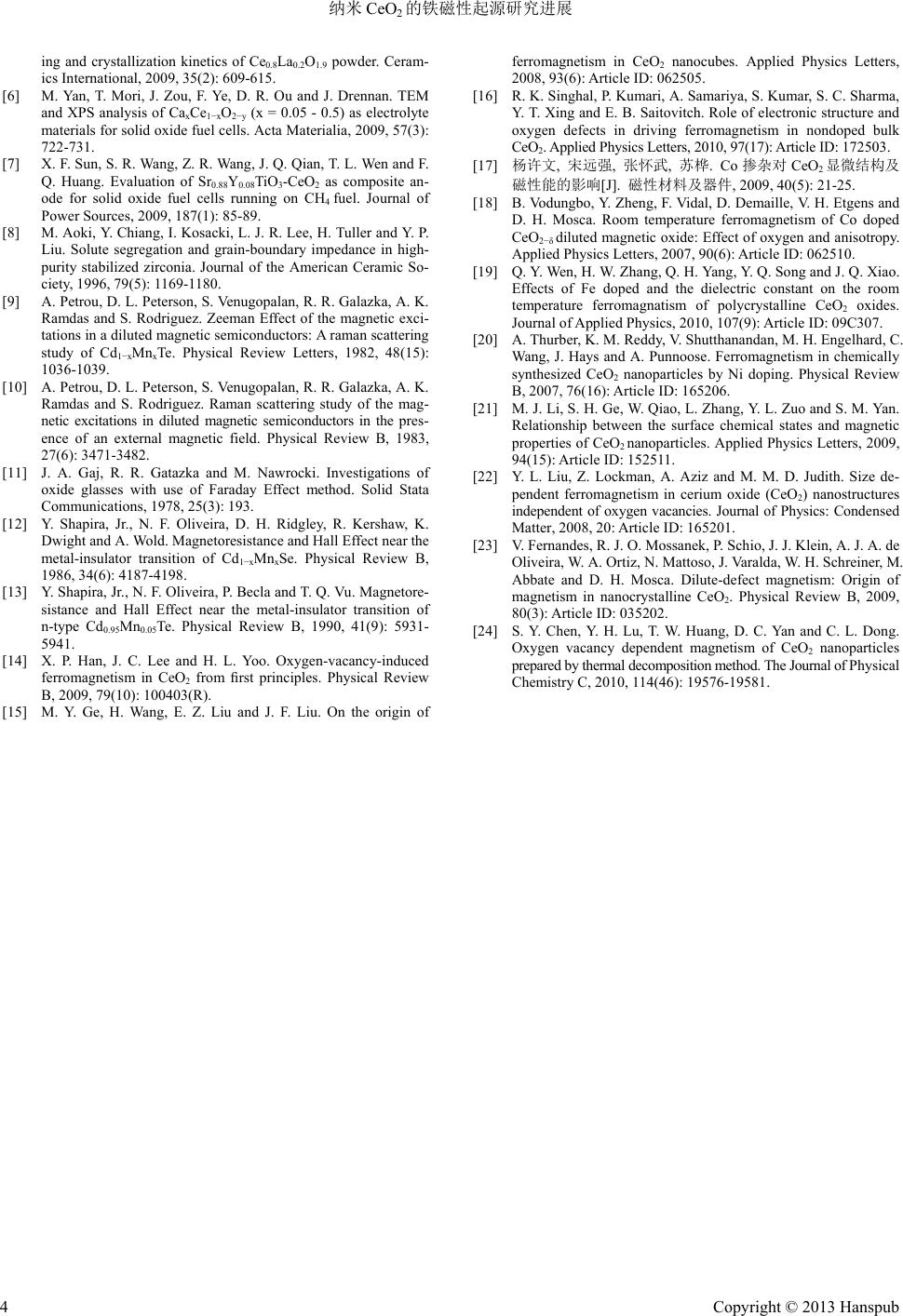 Advances in Condensed Matter Physics 凝聚态物理学进展, 2013, 2, 1-4 http://dx.doi.org/10.12677/cmp.2013.21001 Published Online February 2013 (http://www.hanspub.org/journal/cmp.html) Research Progress of Origin of Ferromagnetic in Nanoparticle CeO2* Jingjing Luo1, Gensheng Zha1, Kunkun Wang1, Fanming Meng1,2# 1School of Physics and Materials Science, Anhui University, Hefei 2Anhui Key Laboratory of Information Materials and Devices, Anhui University, Hefei Email: #mrmeng@ahu.edu.cn Received: Dec. 26th, 2012; revised: Jan. 8th, 2013; accepted: Jan. 19th, 2013 Abstract: CeO2 has a broad application prospect in electronic spin devices due to its ferromagnetic. The research achievements of scholars domestic and overseas in recent years about the origins of the ferromagnetic of CeO2 were discussed in this paper briefly, mainly including oxygen vacancies, doping magnetic ions, Ce3+/Ce4+ pairs on surface, cerium vacancies, consistence of Ce3+ on surface, size of grains, et al. Meanwhile, the problems of the research and re- search direction about the origin ferromagnetic of CeO2 were summed up in this article and looked into the distance. Keywords: CeO2; Ferromagnetic; Origin 纳米 CeO2的铁磁性起源研究进展* 罗婧婧 1,查根胜 1,王坤坤 1,孟凡明 1,2# 1安徽大学物理与材料科学学院,合肥 2安徽大学安徽省信息材料与器件重点实验室,合肥 Email: #mrmeng@ahu.edu.cn 收稿日期:2012 年12 月26日;修回日期:2013 年1月8日;录用日期:2013 年1月19 日 摘 要:CeO2因其具有铁磁性,在电子自旋器件方面有着广泛的应用前景。本文简要概述了近年来国内外学者 关于 CeO2铁磁性起源的研究成果,主要包括氧空位、磁性离子掺杂、表面 Ce3+/Ce4+对、铈空位、表面 Ce3+浓 度、晶粒尺寸等原因。同时,对目前CeO2铁磁性起源研究存在的问题和未来研究方向进行总结和展望。 关键词:CeO2;铁磁性;起源 1. 引言 作为一种廉价的稀土氧化物,二氧化铈(CeO2)因 其独特的4f 电子结构,在磁、电、光、催化等方面呈 现出许多特有的性能,广泛应用于发光[1]、抛光[2]、 紫外吸收[3]、汽车尾气净化[4]、固体氧化物燃料电池 [5-7]、光学涂层[8]等领域。另外,CeO2是一种典型的宽 禁带氧化物半导体,属于立方萤石型结构,晶格常数 与Si 匹配,因此被看作Si 半导体的潜在替换对象。 纳米 CeO2具有室温铁磁性,在自旋电子器件方 面具有潜在的应用和巨大经济效益,因而受到广泛关 注。稀磁半导体呈现出的与电子自旋相关的光学性质 和运输性质,如巨塞曼效应[9,10]、巨法拉第旋转效应[11] 以及巨负磁阻效应[12,13]等,都是制备半导体电子器件 的物理基础。CeO2作为新兴的稀磁氧化物半导体有着 极大地研究和应用价值,而室温铁磁性是它作为稀磁 半导体的关键所在。然而,对于 CeO2纳米粒子室温 铁磁性的来源,学术界存在较大分歧,弄清铁磁性的 产生机制对 CeO2的改进及应用都有重大意义。本文 *基金项目:安徽省自然科学基金项目(1208085ME81);安徽省教育 厅重点项目(KJ2011A010,KJ2012A029);安徽大学 2012 年大学生 创新训练计划项目。 #通讯作者。 Copyright © 2013 Hanspub 1  纳米 CeO2的铁磁性起源研究进展 通过调研大量文献,对 CeO2纳米粒子铁磁性的起源 进行了详细分析与讨论。 2. 纳米 CeO2粒子铁磁性起源 2.1. 氧空位 许多实验结果表明纯 CeO2纳米粒子具有铁磁性, 比如 Han 等[14]采用第一性原理计算表明未掺杂的 CeO2纳米粒子具有铁磁性。在此类文献中,都提到了 CeO2纳米粒子具有铁磁性的原因。由于二氧化铈具有 立方萤石结构,由 O2−构成的简单立方点阵位于面心 立方堆积的Ce4+离子次晶格内,O2−位于阳离子构成 的四面体的中心,如图 1所示,O2−和Ce4+的配位数 分别是 4和8。因此,CeO2晶格在通常条件下存在一 定量的氧空位,这些氧空位就是引起铁磁性的原因。 Ge 等[15]通过实验并用第一性原理计算得到的结 果显示,纯 CeO2纳米粒子中,氧空位导致铈离子的 4f 电子在氧空位周围自旋,如图 2所示,最终导致了 CeO2的净磁矩,从而产生铁磁性。而且,晶粒表面比 晶粒内部的氧空位更易诱发铁磁性。 Singhal 等[16]研究了纳米CeO2室温铁磁性的可逆 性,结果发现顺磁性物质 CeO2经600℃真空退火后产 Ce O Figure 1. Cubic fluorite structure of CeO2 图1. CeO2立方萤石结构 Ce O Oxygen Vacancy Figure 2. Electronic span around oxygen vacancy 图2. 电子绕氧空位自旋 生铁磁性。在室温铁磁性转变过程中,氧空位浓度随 着Ce4+向Ce3+的转变而增加,自由电子占据氧空位, 这对磁化过程起着重要作用。 2.2. 磁性离子掺杂 有些学者通过实验否认氧空位能引发铁磁性,认 为纳米 CeO2粒子本身不具有铁磁性,其铁磁性可通 过掺杂磁性离子获得。比如Yang 等[17]研究发现具有 一定氧空位(VO)的未掺杂 CeO2并不显示铁磁性,Co 离子掺杂使其具有铁磁性,且饱和磁化强度随着 Co 离子浓度的增加先增后减,这是由于 Co~VO~Co 之间 的铁磁交换耦合[18],从而在宏观上体现铁磁性,说明 磁性离子掺杂是CeO2铁磁性的产生原因。Wen 等[19] 通过固相反应法在 1250℃低温烧结获得纯 CeO2纳米 粒子也证实了这种说法,实验结果表明纯 CeO2纳米 粒子是反铁磁性的,而Fe 掺杂的纳米 CeO2样品呈现 明显的室温铁磁性,这是由于掺杂Fe 离子诱发了巨 大的介电常数,从而导致了磁极化子形成和 CeO2强 的室温铁磁性,随着 Fe 含量的增加,饱和磁化强度 先急剧增加然后又以指数形式剧烈减小,这说明磁性 离子的浓度对铁磁性有重要影响。Thurber 等[20]采用 sol-gel 法制备Ni 掺杂的 CeO2纳米粒子,结果表明纯 CeO2纳米粒子和过量掺杂 Ni 的CeO2都不具有铁磁 性,而掺杂少量Ni 的CeO2具有铁磁性,这说明纳米 CeO2的铁磁性是通过掺杂 Ni 而获得的,其本身或者 金属离子杂质都不对铁磁性有贡献。上述表明,纳米 CeO2粒子可通过磁性离子掺杂获得铁磁性。 2.3. CeO2表面 Ce4+与Ce3+的双交换相互作用 有些文献中提到纳米 CeO2的铁磁性与其表面 Ce4+与Ce3+双交换相互作用有密切关系。Li等[21]采用 超声共沉淀法制备了 CeO2纳米粒子,先分别在纯氩 气和氢气、氩气混合气体(H2/Ar = 1:90)中从 200℃到 500℃,每升温 100℃等温还原 2 h,待样品降至室温 后测量其磁性,然后在纯氩气、氢气/氩气混合气体 (H2/Ar = 1:90)和氢气混合气体(H2/Ar = 10:90)三种还 原条件下等温(350℃)还原,还原时间每次增加1 h, 降至室温后测量其磁性。对还原操作过的 CeO2纳米 粒子采用高分辨 XPS测量其表面 Ce3+浓度。结果表 明,CeO2纳米粒子表面 Ce3+/Ce4+混合价电子对对样 品的铁磁性有显著贡献,Ce3+/Ce4+离子对的浓度越高, Copyright © 2013 Hanspub 2  纳米 CeO2的铁磁性起源研究进展 样品铁磁性越强,这是由于 Ce3+和Ce4+之间可能通过 O2−产生双交换相互作用,从而导致了Ce O2纳米粒子 的室温铁磁性。 2.4. 尺寸效应 当粒子维度降低到纳米尺寸时,粒子会出现超常 的磁、光、声、热、电和超导性能,这种现象称为量 子尺寸效应。近几年有报道提出当粒子尺寸达到纳米 量级时纯CeO2具有室温铁磁性,而微米级以上的 CeO2粒子是顺磁性的,这说明晶粒的尺寸对 CeO2的 磁性能有显著影响。 Liu 等[22]在不同溶剂中采用均相沉淀法制备了纳 米CeO2,实验结果表明,只有粒径在20 nm以下的 CeO2粒子具有室温铁磁性。实验过程中 Liu 等通过对 饱和磁化强度的计算对比排除了Fe、Co 等磁性粒子 对CeO2铁磁性的影响,又通过还原退火方法排除了 氧空位对其铁磁性的影响,最终得出纳米 CeO2的尺 寸效应引起了铁磁性,粒子尺寸在 20 nm 以下都能观 察到室温铁磁性。 2.5. 晶格中的铈空位 CeO2晶格中存在氧空位和铈空位,许多报道称纳 米CeO2的铁磁性是由氧空位引起的,然而近来有报 道称铈空位与CeO 2的铁磁性紧密相关。 Fernandes 等[23]通过实验和密度泛函计算结果显 示未掺杂 CeO2纳米粒子具有铁磁性,样品中的氧空 位和铈空位都具有磁矩,分别为 2 μB和4 μB,这是由 于每一个铈空位和 O2p 态相联系,而每一个氧空位又 与Ce4f 态相联系,彼此的相互作用产生了磁矩。通 过激光剥离方法制备的高度结晶化样品呈现顺磁性 以及使用电沉积法制备的高度无序的样品呈现铁磁 性可知,氧空位引起的铁磁性很小,铈空位对样品的 铁磁性有重要贡献。 2.6. CeO2表面 Ce3+浓度 Chen 等[24]采用热分解法制备了纳米 CeO2,实验 结果表明大部分 Ce3+离子都分布在粒子表面,纳米 CeO2的铁磁性与其表面Ce3+的浓度有着密切关系,如 图3所示,当 Ce3+浓度为 43%时,其饱和磁化强度达 到最大值,这个最大值是在没有添加表面活性剂的样 品中测得的,因此可知 Ce3+浓度与 CeO2铁磁性之间 Figure 3. The relationship between concentration of Ce3+ and satu- ration magnetization strength 图3. Ce3+浓度与饱和磁化强度之间的关系 有很大关系。 3. 结论 综上所述,国内外学者从理论计算、制备工艺到 掺杂改进对纳米 CeO2铁磁性起源做了大量研究工作 并取得了许多可喜的成果,提出了氧空位、铈空位、 磁性离子掺杂等可能的磁性起源机理。然而,由于实 验条件、制备方法不同,得出的结论也不尽相同。作 为稀磁氧化物半导体材料,CeO2具有半导体性质的同 时也具有铁磁性,因此可以同时运用其电荷性质和自 旋性质制备新型的电子器件,在磁感应器、高密度非 易失性存储器、半导体集成电路等领域具有广阔的应 用前景。因而,在理论研究方面探索 CeO2的铁磁性 起源机理,进一步认清 CeO2的结构缺陷等因素与铁 磁性的内在联系,基于理论设计出更合理有效的合成 手段来探究 CeO2铁磁性的起源对未来自旋电子器件 的发展有重大意义,是亟待解决的问题,也是未来 CeO2的重要研究方向之一。 参考文献 (References) [1] G. C. Li, K. Chao, H. R. Peng, K. Z. Chen and Z. K. Zhang. Facile synthesis of CePO4 nanowires attached to CeO2 octahe- dral micrometer crystals and their enhanced photoluminescence properties. The Journal of Physical Chemistry C, 2008, 112(42): 16452-16456. [2] X. D. Feng, D. C. Sayle, Z. L. Wang, P. M. Sharon, B. Santora, A. C. Storik, T. X. T. Sayle, Y. Yang, Y. Ding, X. D. Wang and Y. S. Her. Converting ceria polyhedral nanoparticles into single- crystal nanospheres. Science, 2006, 312(5779): 1504-1508. [3] L. Li, Y. S. Chen. Preparation of nanometer-scale CeO2 particles via a complex thermo-decomposition method. Journal of Mate- rials Science and Engineering A, 2005, 406(1): 180-185. [4] R. Di Monte, J. Kaapar. Nanostructured CeO2-ZrO2 mixed ox- ides. Journal of Materials Chemistry, 2005, 15(6): 633. [5] Y. P. Fu, S. H. Chen, F. Y. Tsai and S. H. Hu. Aqueous tape cast- Copyright © 2013 Hanspub 3  纳米 CeO2的铁磁性起源研究进展 Copyright © 2013 Hanspub 4 ing and crystallization kinetics of Ce0.8La0.2O1.9 powder. Ceram- ics International, 2009, 35(2): 609-615. [6] M. Yan, T. Mori, J. Zou, F. Ye, D. R. Ou and J. Drennan. TEM and XPS analysis of CaxCe1−xO2−y (x = 0.05 - 0.5) as electrolyte materials for solid oxide fuel cells. Acta Materialia, 2009, 57(3): 722-731. [7] X. F. Sun, S. R. Wang, Z. R. Wang, J. Q. Qian, T. L. Wen and F. Q. Huang. Evaluation of Sr0.88Y0.08TiO3-CeO2 as composite an- ode for solid oxide fuel cells running on CH4 fuel. Journal of Power Sources, 2009, 187(1): 85-89. [8] M. Aoki, Y. Chiang, I. Kosacki, L. J. R. Lee, H. Tuller and Y. P. Liu. Solute segregation and grain-boundary impedance in high- purity stabilized zirconia. Journal of the American Ceramic So- ciety, 1996, 79(5): 1169- 1180. [9] A. Petrou, D. L. Peterson, S. Venugopalan, R. R. Galazka, A. K. Ramdas and S. Rodriguez. Zeeman Effect of the magnetic exci- tations in a diluted magnetic semiconductors: A raman scattering study of Cd1−xMnxTe. Physical Review Letters, 1982, 48(15): 1036-1039. [10] A. Petrou, D. L. Peterson, S. Venugopalan, R. R. Galazka, A. K. Ramdas and S. Rodriguez. Raman scattering study of the mag- netic excitations in diluted magnetic semiconductors in the pres- ence of an external magnetic field. Physical Review B, 1983, 27(6): 3471-3482. [11] J. A. Gaj, R. R. Gatazka and M. Nawrocki. Investigations of oxide glasses with use of Faraday Effect method. Solid Stata Communications, 1978, 25(3): 193. [12] Y. Shapira, Jr., N. F. Oliveira, D. H. Ridgley, R. Kershaw, K. Dwight and A. Wold. Magnetoresistance and Hall Effect near the metal-insulator transition of Cd1−xMnxSe. Physical Review B, 1986, 34(6): 4187-4198. [13] Y. Shapira, Jr., N. F. Oliveira, P. Becla and T. Q. Vu. Magnetore- sistance and Hall Effect near the metal-insulator transition of n-type Cd0.95Mn0.05Te. Physical Review B, 1990, 41(9): 5931- 5941. [14] X. P. Han, J. C. Lee and H. L. Yoo. Oxygen-vacancy-induced ferromagnetism in CeO2 from first principles. Physical Review B, 2009, 79(10): 100403(R). [15] M. Y. Ge, H. Wang, E. Z. Liu and J. F. Liu. On the origin of ferromagnetism in CeO2 nanocubes. Applied Physics Letters, 2008, 93(6): Article ID: 062505. [16] R. K. Singhal, P. Kumari, A. Samariya, S. Kumar, S. C. Sharma, Y. T. Xing and E. B. Saitovitch. Role of electronic structure and oxygen defects in driving ferromagnetism in nondoped bulk CeO2. Applied Physics Letters, 2010, 97(17): Article ID: 172503. [17] 杨许文, 宋远强, 张怀武, 苏桦. Co掺杂对 CeO2显微结构及 磁性能的影响[J]. 磁性材料及器件, 2009, 40(5): 21-25. [18] B. Vodungbo, Y. Zheng, F. Vidal, D. Demaille, V. H. Etgens and D. H. Mosca. Room temperature ferromagnetism of Co doped CeO2−δ diluted magnetic oxide: Effect of oxygen and anisotropy. Applied Physics Letters, 2007, 90(6): Article ID: 062510. [19] Q. Y. Wen, H. W. Zhang, Q. H. Yang, Y. Q. Song and J. Q. Xiao. Effects of Fe doped and the dielectric constant on the room temperature ferromagnatism of polycrystalline CeO2 oxides. Journal of Applied Physics, 2010, 107(9): Article ID: 09C307. [20] A. Thurber, K. M. Reddy, V. Shutthanandan, M. H. Engelhard, C. Wang, J. Hays and A. Punnoose. Ferromagnetism in chemically synthesized CeO2 nanoparticles by Ni doping. Physical Review B, 2007, 76(16): Article ID: 165206. [21] M. J. Li, S. H. Ge, W. Qiao, L. Zhang, Y. L. Zuo and S. M. Yan. Relationship between the surface chemical states and magnetic properties of CeO2 nanoparticles. Applied Physics Letters, 2009, 94(15): Article ID: 152511. [22] Y. L. Liu, Z. Lockman, A. Aziz and M. M. D. Judith. Size de- pendent ferromagnetism in cerium oxide (CeO2) nanostructures independent of oxygen vacancies. Journal of Physics: Condensed Matter, 2008, 20: Article ID: 165201. [23] V. Fernandes, R. J. O. Mossanek, P. Schio, J. J. Klein, A. J. A. de Oliveira, W. A. Ortiz, N. Mattoso, J. Varalda, W. H. Schreiner, M. Abbate and D. H. Mosca. Dilute-defect magnetism: Origin of magnetism in nanocrystalline CeO2. Physical Review B, 2009, 80(3): Article ID: 035202. [24] S. Y. Chen, Y. H. Lu, T. W. Huang, D. C. Yan and C. L. Dong. Oxygen vacancy dependent magnetism of CeO2 nanoparticles prepared by thermal decomposition method. The Journal of Physical Chemistry C, 2010, 114(46): 19576-19581. |